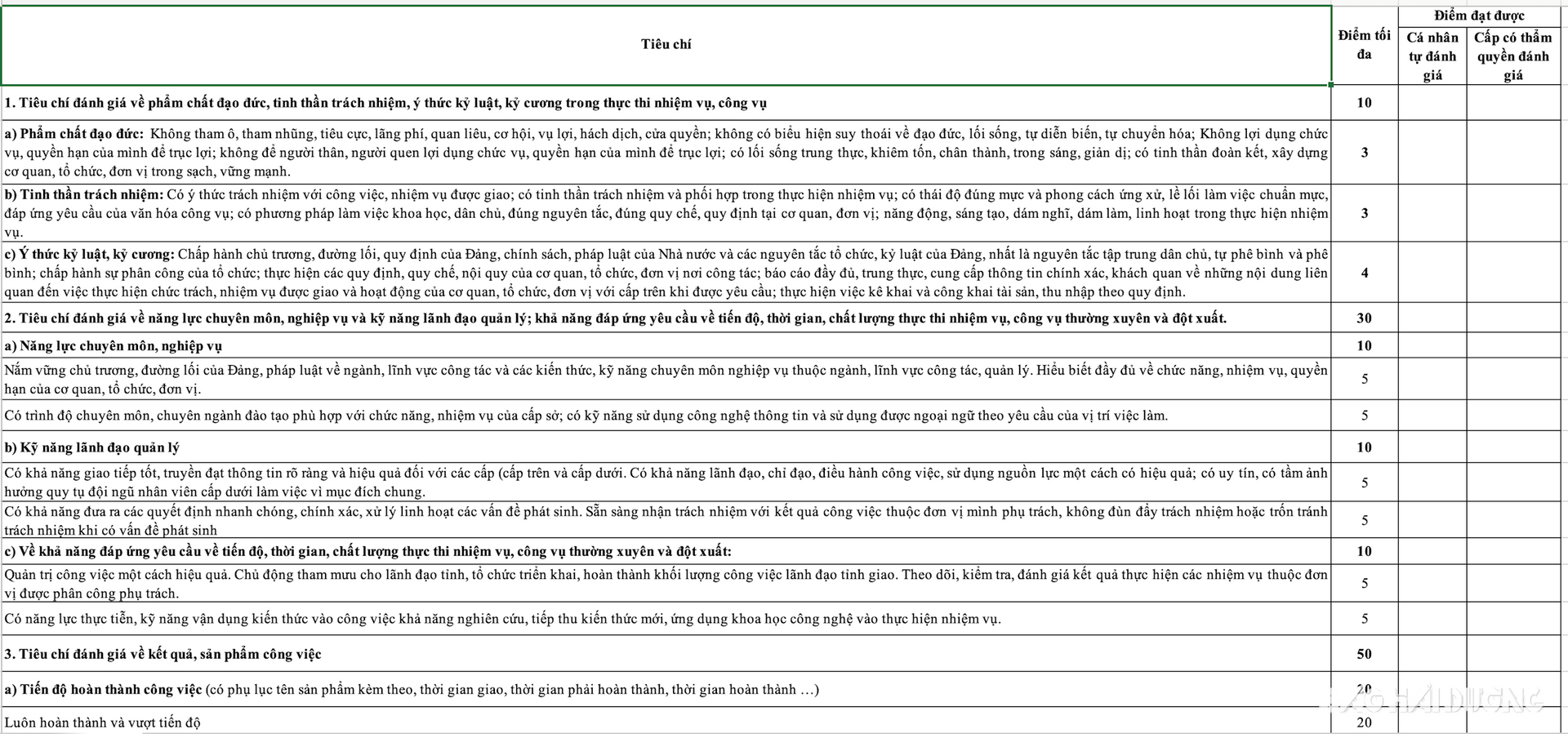According to the guidance of Hai Duong Provincial People's Committee, there are 3 criteria frameworks to evaluate 3 groups of cadres, civil servants and public employees when arranging the apparatus and streamlining the payroll.

Specific assessment scale for each subject
The People's Committee of Hai Duong province has just issued guidelines on criteria for evaluating cadres, civil servants, public employees, and workers in the government sector to reorganize the apparatus, streamline the payroll, restructure, improve the quality of cadres, civil servants, and public employees, and resolve policies and regimes according to regulations.
According to the instructions, the subjects of assessment are cadres, civil servants, public employees, and workers at agencies, units, and localities of the province (including commune-level cadres and civil servants) subject to the regulations of Decree No. 178/2024/ND-CP and Decree No. 67/2025/ND-CP.
In principle, the collective leadership of the Party Committee and the heads of agencies, units, and localities managing cadres, civil servants, public employees, and workers decide on the assessment, screening, and selection of those who will resign according to their authority, in conjunction with the restructuring and improvement of the quality of the cadres, civil servants, public employees, and workers under their management.
Evaluation is done according to the criteria of each position group.
Jobs (management leadership positions, specialized professional positions, shared professional professional positions, service support positions) suitable to the characteristics, situation and practices of the agency, unit, and locality.
The assessment results are the basis for implementing policies for those with outstanding qualities, talents, and abilities, who meet the requirements of the job, to continue to work; those who need training and improvement to meet the requirements of the job position; at the same time, correctly identify the subjects who retire (retire early or quit) to enjoy the policy according to regulations through screening and arranging the order of cadres, civil servants, public employees, and workers.

The resolution of dismissal in cases of voluntary application must be approved by the head of the agency, unit or locality. If not approved, the head of the agency, unit or locality must respond in writing and state the reasons.
Cases of voluntary resignation have not been considered or resolved but are assessed to have outstanding qualities and abilities, dare to think, dare to do, dare to take responsibility for the common good, have exemplary achievements, and bring benefits to the agency, unit, and locality.
In case the head of an agency, unit or locality has issued a document not agreeing to the resignation of an official, civil servant, public employee or employee who has voluntarily applied for resignation, but the official, civil servant, public employee or employee still wishes to resign, the competent authority shall immediately resolve the resignation and shall not be entitled to the benefits under Decree No. 178/2024/ND-CP and Decree No. 67/2025/ND-CP.
According to the guidelines, there are 3 criteria frameworks for 3 groups of subjects, including: cadres, civil servants, and leaders at the department level and equivalent; department level and equivalent; and cadres, civil servants, and officials who do not hold management positions. The maximum score for each framework is 100.
See detailed scoring scale for each target group in the criteria frames:
For employees, based on the criteria in the evaluation criteria framework for cadres, civil servants and public employees not holding management positions, agencies and units develop specific criteria suitable for the work under the labor contract.
Ensure the reduction in the number of cadres, civil servants, public employees and workers who have to take leave
The assessment is carried out at the time before submitting to the competent authority for consideration and implementation of policies for cases with outstanding capacity, qualities and talents, cases requiring training and improvement of qualifications after arrangement (if any) and consideration and settlement of subjects who quit their jobs and enjoy policies according to Decree No. 178/2024/ND-CP and Decree No. 67/2025/ND-CP of the Government.
Based on the assessment scores for each individual in ascending order and the minimum reduction rate as prescribed in Official Dispatch No. 31/CV-BCĐTKNQ18 and related regulations, the competent authority shall decide on the subjects who must quit their jobs due to organizational arrangement, streamlining of staff, restructuring, and improving the quality of cadres, civil servants, and public employees.
Specifically, for cadres, civil servants and public employees holding leadership and management positions, implementation is based on prescribed norms (determining surplus) and evaluation results according to job position groups (including both heads and deputies).
For civil servants and public employees not holding leadership positions, the number of remaining cadres, civil servants, public employees and workers who must retire (after deducting the number of cadres, civil servants, public employees holding leadership and management positions) must be reduced by at least 20% of civil servants, public employees and workers receiving salaries from the state budget in agencies and units in accordance with the policy settlement roadmap prescribed in Decree No. 178/2024/ND-CP of the Government.
Evaluation Procedure
Step 1: The head of the agency or unit consults the collective leadership of the Party Committee and the government at the same level to issue evaluation criteria and a scale for component criteria to ensure that they are suitable for the characteristics of the agency or unit. Disseminate and publicly disseminate these to each cadre, civil servant, public employee, and worker in the agency or unit.
Step 2: Based on the assessment criteria of the agency, unit, cadres, civil servants, public employees and workers self-assess and score.
Step 3. The department and equivalent units where the cadres, civil servants, public employees and workers work organize meetings to review and evaluate each cadre, civil servant and public employee and summarize the results and report to the agency and unit leaders for consideration and decision.
Step 4: Based on the evaluation results in steps 2 and 3, the head of the agency or unit asks for opinions from the Party Committee, leadership team, and trade union at the same level on the evaluation results of cadres, civil servants, public employees, and workers.
Step 5. The head of the agency or unit decides on the results of the assessment of task performance or submits them to the competent authority for assessment according to the management hierarchy of personnel work; publicly announces the results of the assessment of cadres, civil servants, public employees and workers.
Step 6: Make a list, estimate the amount and request the competent authority to implement the policy regime according to Decree No. 178/2024/ND-CP and Decree No. 67/2025/ND-CP.